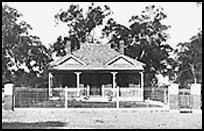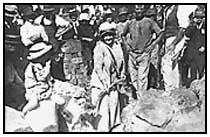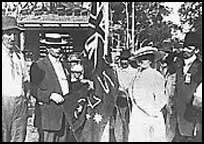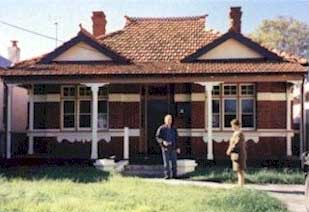
The Anzacs were still fighting in the gullies of Gallipoli when, in October 1915, the Mount Hawthorn Progress Association formed a committee to build ‘Anzac Cottage’ (sometimes called ‘Anzac House’) in Kalgoorlie St, (No. 38) Mt Hawthorn, a developing suburb 5 kilometres north of Perth. The Association wanted to perpetuate the then very new name ‘Anzac’ and build a monument that would be useful, providing ‘a home for a wounded soldier who took part in the famous landing’.

Members of the Progress Association started the fund-raising by contributing the large sum of 5 pounds each and the heavily timbered bush block was prepared by volunteer labour on Saturday, January 29, 1916, ‘when about 30 men assembled armed with shovels, saws and axes, to clear the land’. ‘At 4 o’ clock the Ladies Patriotic Guild regaled the workers with afternoon tea’. After this, the last standing tree – they called it ‘Lone Pine’ – was felled.
The following Saturday, February 5, seventy drays loaded with donated building materials, formed a spectacular half-mile procession through James St, Perth, accompanied by about 150 men, all on their way to the Mt Hawthorn building site:
Mrs Roberts, the ‘Soldiers’ Queen’, headed the procession in her motor car, which also carried a Metters stove and copper, and was accompanied by two other decorated motor cars. Then came 20 drays of stone, 27 of bricks, one of lime, 3 of tiles, 12 of timber, 1 of cement and paints, 1 of scaffolding, 1 tiled grate, 1 large enamel bath, 1 of refreshments and 1 of sundries. The procession was viewed by thousands as it proceeded to Mt Hawthorn and, on arrival at ‘Anzac’, was greeted by hundreds of enthusiastic men, women and children.

On Saturday the twelfth of February, the ‘busy bee’ construction of the house commenced at 3.30 am and by 1pm the number of volunteer workmen on the site had reached two hundred. The first sod was ceremonially turned by the ‘Soldiers’ Queen’. Hot dinners were provided for the tradesmen, the Police Band provided the music and a local rifle club fielded the Honour Guard for the Governor, and for his wife, Lady Barron, who laid the inscribed foundation tablet. A crowd of thousands, it was claimed, looked on in their Sunday-best. Construction of the house was completed by ‘bed time’. As the official souvenir booklet of the event put it, ‘Mount Hawthorn was en fete…’.all that day.

(Anzac Cottage souvenir booklet
2nd edition – 1916)
The festivities were repeated when the cottage was officially opened by Premier and Mrs Scaddan on April 15 and handed over to the returned Anzac the following day – a Sunday. There was more celebrating then, including bands, cadets and Girl Guides. A flag-pole had been built in the front garden upon which the Australian flag – bearing the motto ‘Anzac’ – was to be hoisted each Anzac Day at 4.30am, the time of the first landing at Gallipoli.
Anzac Cottage was to house a returned Gallipoli digger and his descendants for as long as they needed, to ‘ensure that the cottage will remain for all time a monument to what Lord Kitchener has termed “A remarkable record of valour” ‘. Private C. J. Porter and his wife, Anne, were the lucky couple granted the cottage, their good fortune deriving from Porter’s participation in the fighting at Gallipoli, where he had been wounded. Porter publicly declined the home, saying he did not wish to receive something his comrades in arms could not have. But he was prevailed upon to accept the honour. The Porters and their four daughters lived in the house for many years. Private Porter died in 1964, his wife four years later, and some descendants did indeed live on in the cottage until the 1970s.
In 1991, after a period of uncertain ownership and legal difficulties, the cottage passed into the keeping of the Vietnam Veterans’ Association of Australia, WA branch. In cooperation with the Mt Hawthorn Anzac Cottage Restoration Group and with a grant from the Lotteries Commission and the generosity of many donors, the VVAAWA restored the building as closely as possible to its original condition in 1995-6. The cottage is now the headquarters of the VVAAWA.
In 1996 a new tradition of the ‘Sunset Service’ was established at the Cottage. A brief but effective ceremony, this event is the last Anzac Day observation in the nation. Currently the Historic Gardens Association of Western Australia is restoring the front garden and fence and a grand re-enactment of the original cottage opening ceremony is planned for April, 2002.
Anzac Cottage has been Classified by the National Trust, by the WA Heritage Council and is included in the Register of the National Estate. As well as having outstanding local, state and national heritage significance, Anzac Cottage is the country’s earliest World War 1 memorial – and perhaps the most unique of the Australia’s many war memorials. It is also a folk building, having been erected as part of the grassroots response to the Gallipoli campaign and, through its place in the suburban community, part of local lore and legend.
On April 7 this year there will be a reenactment of the original handing over ceremony at Anzac Cottage. As well as other dignitaries, the Premier and Governor will take part in a re-dedication of the cottage in which a permanent display of its history will be initiated.
© Graham Seal
Dr Graham Seal is Director of the WA Folklore Archive at Curtin University, Perth. He has been collecting, performing and writing about Australian folklore, past and present, for many years and has published a number of books.
sources
- Anzac Cottage Souvenir booklet,
2nd edn.1916. - Gray, L., Anzac Cottage Conservation Plan, March 1996.
- Western Mail, Feb 4, 1916, p.29; Feb. 11, pp. 20, 28; Feb. 18, p. 25; 23/4/55.
- Sunday Times, 13/12/16, p.9.
- West Australian 25/4/63; 26/4/63;14/4/64.
- Westralian Worker, 1915-1916.
- City of Perth Planning Scheme Review, Map P25.2, 30 July, 1990. (The cottage is now within the local government area of the Town of Vincent).
- National Trust of Australia (WA) Built Environment Committee Assessment by Kelly, Aris & Sefton, 1989.

